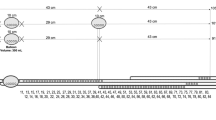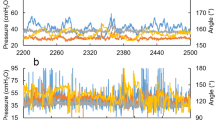Abstract
Anal ultra slow waves (USWs) have been describedin a variety of anorectal disorders, all of which may beassociated with constipation. We investigated whetherthey represent a marker for dyschezia and whether their occurrence can be modified.Manometric and endosonographic studies were performed in25 patients with dyschezia, in 25 age- and sex-matchedcontrols, and in an equal number of patients with hemorrhoids. Patients exhibiting ultra slowwaves were repeatedly studied with and without localadministration of isosorbide dinitrate. In addition, wedetermined whether stimulatory maneuvers modify the occurrence of USWs. Anal USWs were persistentlyfound in 56% of patients with dyschezia, in 8% ofpatients with hemorrhoids, and in none of the healthycontrols. They were stimulated by anal squeeze and completely abolished by local administration ofisosorbide dinitrate. Ultra slow waves always occurredin conjunction with an increase in anal resting pressureand were tightly associated with a fluctuation in slow wave amplitude. Anal sphinctermorphology was similar in patients with dyschezia and incontrols. We conclude that anal USWs occur mostfrequently in patients with dyschezia and indicatesmooth muscle dysfunction. Treatment directed atabolishing this motor phenomenon may represent a novelapproach to the management of patients withdyschezia.
Similar content being viewed by others
REFERENCES
Kumar D, Williams NS, Waldron D, Wingate DL: Prolonged manometric recording of anorectal motor activity in ambulant human subjects: Evidence of periodic activity. Gut 30:1007–1011, 1989
Orkin BA, Hanson RB, Kelly KA, Phillips SF, Dent J: Human anal motility while fasting, after feeding, and during sleep. Gastroenterology 100:1016–1023, 1991
Enck P, Eggers E, Koletzko S, Erckenbrecht JF: Spontaneous variation of anal “resting” pressure in healthy humans. Am J Physiol 261:G823–G826, 1991
Hancock BD: Measurement of anal pressure and motility. Gut 17:645–651, 1976
Mellerup Sorensen S, Gregersen H, Sorensen S, Djurhuus JC: Spontaneous anorectal pressure activity. Evidence of internal anal sphincter contractions in response to rectal pressure waves. Scand J Gastroenterol 24:115–200, 1989
Hancock BD: The internal sphincter and anal fissure. Br J Surg 64:92–95, 1977
Schouten WR, Blankenstejn JD: Ultra slow wave pressure variations in the anal canal before and after lateral internal sphincterotomy. Int J Colorectal Dis 7:115–118, 1992
Xynos E, Tzorzinis A, Chrysos E, Tzovaras G, Vassilakis JS: Anal manometry in patients with fissure-in-ano before and after internal sphincterotomy. Int J Colorectal Dis 8:125–128, 1993
Hancock BD, Smith K: The internal sphincter and Lord's procedure for hemorrhoids. Br J Surg 62:833–836, 1975
Read MG, Read NW, Haynes WG, Donnelly TC, Johnson AG: A prospective study of the effect of hemorrhoidectomy on sphincter function and faecal continence. Br J Surg 69:396–398, 1982
Kamm MA, Hoyle CHV, Burleigh DE, Law PJ, Swash M, Martin JE, Nicholls RJ, Northover JMA: Hereditary internal anal sphincter myopathy causing proctalgia fugax and constipation. A newly identified condition. Gastroenterology 100:805–810, 1991
Celik AF, Katsinelos P, Read NW, Khan MI, Donnelly TC: Hereditary proctalgia fugax and constipation: Report of a second family. Gut 36:581–584, 1995
Shafik A: The pathogenesis of hemorrhoids and their treatment by anorectal bandotomy. J Clin Gastroenterol 6:129–137, 1984
Hancock BD: Internal sphincter and the nature of hemorrhoids. Gut 18:651–655, 1977
Johanson JF, Sonnenberg A, Koch TR, McCarty DJ: Association of constipation with neurologic diseases. Dig Dis Sci 37:179–186, 1992
Whitehead WE, Working Team for Functional Disorders of Anus and Rectum: Functional disorders of the anus and rectum. In The Functional Gastrointestinal Disorders. Diagnosis, Pathophysiology, and Treatment. DA Drossman (ed). Boston, Little, Brown and Company, pp 217–263, 1994
Eckardt VF, Nix W: The anal sphincter in patients with myotonic muscular dystrophy. Gastroenterology 100:424–430, 1991
Eckardt VF, Dodt O, Kanzler G, Bernhard G: Anorectal function and morphology in patients with sporadic proctalgia fugax. Dis Colon Rectum 39:755–762, 1996
Ducrotté P, Denis P, Hellot M-F, Desechalliers J-P, Colin R, Pasquis P, Hecketsweiler P: Motricité anorectale dans la constipation idiopathique. Étude de 200 patients consécutive. Gastroenterol Clin Biol 9:10–15, 1985
Golenhofen K: In Smooth Muscle. E Bülbring, AF Brading, AW Jones, T Tomita (eds). London, Edward Arnold, 1970, pp 316–342
Frenckner B, Ihre T: Influence of autonomic nerves on the internal anal sphincter in man. Gut 17:306–312, 1976
Kerremans R: Morphological and Physiological Aspects of Anal Continence. Brussels, Edition Arscia, 1969
Wankling WJ, Brown BH, Collins CD, Duthie HL: Basal electrical activity in the anal canal in man. Gut 9:457–460, 1968
Guillemot F, Leroi H, Lo YC, Rousseau CG, Lamblin M-D, Cortot A: Action of in situ nitroglycerin on upper anal canal pressure of patients with terminal constipation. A pilot study. Dis Colon Rectum 36:372–376, 1993
Loder PB, Kamm MA, Nicholls RJ, Phillips RKS: “Reversible chemical sphincterotomy” by local application of glyceryl trinitrate. Br J Surg 81:1386–1389, 1994
Gorfine SR: Treatment of benign anal disease with topical nytroglycerin. Dis Colon Rectum 38:453–457, 1995
Schouten WR, Briel JW, Boerma MO, Auwerda JJA, Wils EB, Graatsma BH: Pathophysiological aspects and clinical outcome of intra-anal application of isosorbide dinitrate in patients with chronic anal fissure. Gut 39:465–469, 1996
Whitehead WE, Engel BT, Schuster MM: Irritable bowel syndrome. Physiological and psychological differences between diarrhea-predominant and constipation-predominant patients. Dig Dis Sci 25:404–413, 1980
Meathers SE, Kempster PA, Swash M, Lees AJ: Constipation and paradoxical contraction in anismus and Parkinson's disease: A dystonic phenomenon? J Neurol Neurosurg Psychol 51:1503–1507, 1988
Lestar B, Penninckx F, Kerremans R: Biofeedback defaecation training for anismus. Int J Colorect Dis 6:202–207, 1991
Enck P: Biofeedback training in disordered defecation. A critical review. Dig Dis Sci 38:1953–1960, 1993
Keck JO, Staniunas RJ, Coller JA, Barrett RC, Oster ME, Schoetz DJ Jr, Roberts PL, Murray JJ, Veidenheimer MC: Biofeedback training is useful in fecal incontinence but disappointing in constipation. Dis Colon Rectum 37:1271–1276, 1994
Weber J, Ducrotte P, Touchais JY, Roussignol C, Denis P: Biofeedback training for constipation in adults and children. Dis Colon Rectum 30:844–846, 1987
Martelli H, Devroe de G, Arhan P, Duguay C: Mechanism of idiopathic constipation: outlet obstruction. Gastroenterology 75:623–631, 1978
Yoshioka K, Keighley RB: Randomized trial comparing anorectal myectomy and controlled anal dilation for outlet obstruction. Br J Surg 74:1125–1129, 1987
Rights and permissions
About this article
Cite this article
Eckardt, V.F., Schmitt, T. & Bernhard, G. Anal Ultra Slow Waves (A Smooth Muscle Phenomenon Associated with Dyschezia). Dig Dis Sci 42, 2439–2445 (1997). https://doi.org/10.1023/A:1018887823089
Issue Date:
DOI: https://doi.org/10.1023/A:1018887823089




